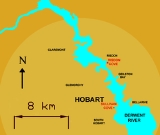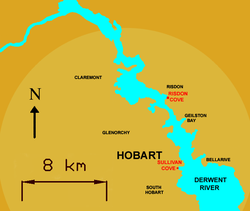
Risdon Cove
Encyclopedia
Risdon Cove was the site of the first British
settlement in Van Diemen's Land
, now Tasmania
, the smallest Australian state. Risdon Cove, which was named after William Bellamy Risdon, second officer of the ship Duke of Clarence. Risdon served under Lt. John Hayes, who had mapped the area of Risdon Cove and river as early as 1793.
 In 1803 Lieutenant John Bowen
In 1803 Lieutenant John Bowen
was sent to establish a settlement in Van Diemen's Land. On the advice of the explorer Bass he had chosen Risdon Cove. While the site was a good one from a defensive point of view, the soil was poor and water scarce.
The Lady Nelson
anchored at Risdon on the eastern shore of the Derwent River
on Wednesday 8 September 1803, five days before the whaler Albion
arrived with Lt. Bowen on board.
The 49 people aboard the Lady Nelson
and Albion
made a curious party of soldiers, sailors, settlers and convicts.
In 1804 Lieutenant Colonel David Collins
arrived in the Derwent from Port Phillip. Within a few days he rejected Risdon Cove as a suitable settlement site, for its inadequate source of fresh water, and moved his party across the river to Sullivans Cove. The military and convicts disembarked from the Ocean near Hunter Island on the 20–21 February 1804 and thus beginning what is now Hobart
. The free settlers were landed from the Lady Nelson at New Town Bay on 22 February.
(a small cannon used for firing salutes at the settlement) in an attempt to disperse the aboriginals; it is not known if this was a blank round, although some allege grape shot was used to explain an alleged but uncorroborated high figure of deaths. In addition, two soldiers fired musket
s in protection of a Risdon Cove settler being beaten on his farm by aboriginals carrying waddies (clubs). These soldiers killed one aboriginal outright, and mortally wounded another, who was later found dead in a valley. Moore's account lists three killed and some wounded. It is therefore known that in the conflict some aboriginals were killed, and that the colonists "had reason to Suppose more were wounded, as one was seen to be taken away bleeding". It is also known that an infant boy about 2–3 years old was left behind in what was viewed as a "retreat from a hostile attempt made upon the borders of the settlement". "There were a great many of the Natives slaughtered and wounded" according to the Edward White, an Irish convict who later spoke before a committee of inquiry nearly 30 years later in 1830, but could not give exact figures. White alleged to have been an eyewitness, although he was working in a creek bed where the escarpment prevented him from viewing events, claiming to be the first to see the approaching aboriginals, and also said that "the natives did not threaten me; I was not afraid of them; (they) did not attack the soldiers; they would not have molested them; they had no spears with them; only waddies", though that they had no spears with them is questionable, and his claims need to be assessed with caution. His contemporaries had believed the approach to be a potential attack by a group of aboriginals that greatly outnumbered the colonists in the area, and spoke of "an attack the natives made", their "hostile Appearance", and "that their design was to attack us". A macabre postscript to the story was an allegation that the bones of some of the Aborigines were shipped to Sydney in two casks, though there is no supportive evidence of this.
The hand-over of the Risdon Cove site, which includes the Bowen Memorial, was part of the Aboriginal Lands Bill. The transfer occurred on 11 December 1995, and the historic relics have since unfortunately fallen into disrepair.
United Kingdom of Great Britain and Ireland
The United Kingdom of Great Britain and Ireland was the formal name of the United Kingdom during the period when what is now the Republic of Ireland formed a part of it....
settlement in Van Diemen's Land
Van Diemen's Land
Van Diemen's Land was the original name used by most Europeans for the island of Tasmania, now part of Australia. The Dutch explorer Abel Tasman was the first European to land on the shores of Tasmania...
, now Tasmania
Tasmania
Tasmania is an Australian island and state. It is south of the continent, separated by Bass Strait. The state includes the island of Tasmania—the 26th largest island in the world—and the surrounding islands. The state has a population of 507,626 , of whom almost half reside in the greater Hobart...
, the smallest Australian state. Risdon Cove, which was named after William Bellamy Risdon, second officer of the ship Duke of Clarence. Risdon served under Lt. John Hayes, who had mapped the area of Risdon Cove and river as early as 1793.

John Bowen (colonist)
John Bowen was a naval officer and colonial administrator. Led the first settlement of Tasmania at Risdon Cove. He was the son of James Bowen, and was born at Ilfracombe, Devon, England.-Early career:...
was sent to establish a settlement in Van Diemen's Land. On the advice of the explorer Bass he had chosen Risdon Cove. While the site was a good one from a defensive point of view, the soil was poor and water scarce.
The Lady Nelson
Lady Nelson
The Royal Navy purchased Lady Nelson in 1799. She spent her career exploring the coast of Australia in the early years of the 19th century. She was the first known vessel to sail eastward through Bass Strait, the first to sail along the South coast of Victoria, as well as the first to enter Port...
anchored at Risdon on the eastern shore of the Derwent River
Derwent River (Tasmania)
The Derwent is a river in Tasmania, Australia. It was named after the River Derwent, Cumbria by British Commodore John Hayes who explored it in 1793. The name is Brythonic Celtic for "valley thick with oaks"....
on Wednesday 8 September 1803, five days before the whaler Albion
Albion
Albion is the oldest known name of the island of Great Britain. Today, it is still sometimes used poetically to refer to the island or England in particular. It is also the basis of the Scottish Gaelic name for Scotland, Alba...
arrived with Lt. Bowen on board.
The 49 people aboard the Lady Nelson
Lady Nelson
The Royal Navy purchased Lady Nelson in 1799. She spent her career exploring the coast of Australia in the early years of the 19th century. She was the first known vessel to sail eastward through Bass Strait, the first to sail along the South coast of Victoria, as well as the first to enter Port...
and Albion
Albion
Albion is the oldest known name of the island of Great Britain. Today, it is still sometimes used poetically to refer to the island or England in particular. It is also the basis of the Scottish Gaelic name for Scotland, Alba...
made a curious party of soldiers, sailors, settlers and convicts.
In 1804 Lieutenant Colonel David Collins
David Collins (governor)
Colonel David Collins was the first Lieutenant Governor of the Colony of Van Diemens Land, founded in 1804, which in 1901 became the state of Tasmania in the Commonwealth of Australia.-Early life and military career:...
arrived in the Derwent from Port Phillip. Within a few days he rejected Risdon Cove as a suitable settlement site, for its inadequate source of fresh water, and moved his party across the river to Sullivans Cove. The military and convicts disembarked from the Ocean near Hunter Island on the 20–21 February 1804 and thus beginning what is now Hobart
Hobart
Hobart is the state capital and most populous city of the Australian island state of Tasmania. Founded in 1804 as a penal colony,Hobart is Australia's second oldest capital city after Sydney. In 2009, the city had a greater area population of approximately 212,019. A resident of Hobart is known as...
. The free settlers were landed from the Lady Nelson at New Town Bay on 22 February.
3 May 1804
The original records show that a large group of Aborigines blundered into the British settlement. The soldiers mistakenly thought they were under attack and killed some of the intruders. About 300 aboriginals, men, women and children, who had banded together approached the Risdon Cove settlement whilst occupied on a kangaroo hunt during a seasonal migration. The Aborigines had arrived at the settlement and some were justifiably upset by the presence of the colonists. There had been no widespread aggression, but if their displeasure spread and escalated, Lt. Moore, the commanding officer at the time, and his dozen or so soldiers, could not be expected to be able to protect the settlement from a mob of such size. The soldiers were therefore ordered to fire a carronadeCarronade
The carronade was a short smoothbore, cast iron cannon, developed for the Royal Navy by the Carron Company, an ironworks in Falkirk, Scotland, UK. It was used from the 1770s to the 1850s. Its main function was to serve as a powerful, short-range anti-ship and anti-crew weapon...
(a small cannon used for firing salutes at the settlement) in an attempt to disperse the aboriginals; it is not known if this was a blank round, although some allege grape shot was used to explain an alleged but uncorroborated high figure of deaths. In addition, two soldiers fired musket
Musket
A musket is a muzzle-loaded, smooth bore long gun, fired from the shoulder. Muskets were designed for use by infantry. A soldier armed with a musket had the designation musketman or musketeer....
s in protection of a Risdon Cove settler being beaten on his farm by aboriginals carrying waddies (clubs). These soldiers killed one aboriginal outright, and mortally wounded another, who was later found dead in a valley. Moore's account lists three killed and some wounded. It is therefore known that in the conflict some aboriginals were killed, and that the colonists "had reason to Suppose more were wounded, as one was seen to be taken away bleeding". It is also known that an infant boy about 2–3 years old was left behind in what was viewed as a "retreat from a hostile attempt made upon the borders of the settlement". "There were a great many of the Natives slaughtered and wounded" according to the Edward White, an Irish convict who later spoke before a committee of inquiry nearly 30 years later in 1830, but could not give exact figures. White alleged to have been an eyewitness, although he was working in a creek bed where the escarpment prevented him from viewing events, claiming to be the first to see the approaching aboriginals, and also said that "the natives did not threaten me; I was not afraid of them; (they) did not attack the soldiers; they would not have molested them; they had no spears with them; only waddies", though that they had no spears with them is questionable, and his claims need to be assessed with caution. His contemporaries had believed the approach to be a potential attack by a group of aboriginals that greatly outnumbered the colonists in the area, and spoke of "an attack the natives made", their "hostile Appearance", and "that their design was to attack us". A macabre postscript to the story was an allegation that the bones of some of the Aborigines were shipped to Sydney in two casks, though there is no supportive evidence of this.
20th century
The site at Risdon Cove was farmed until 1948. By the 150th anniversary celebrations (Sept 1954) land had been acquired by the State Government to add to the reserve.The hand-over of the Risdon Cove site, which includes the Bowen Memorial, was part of the Aboriginal Lands Bill. The transfer occurred on 11 December 1995, and the historic relics have since unfortunately fallen into disrepair.

